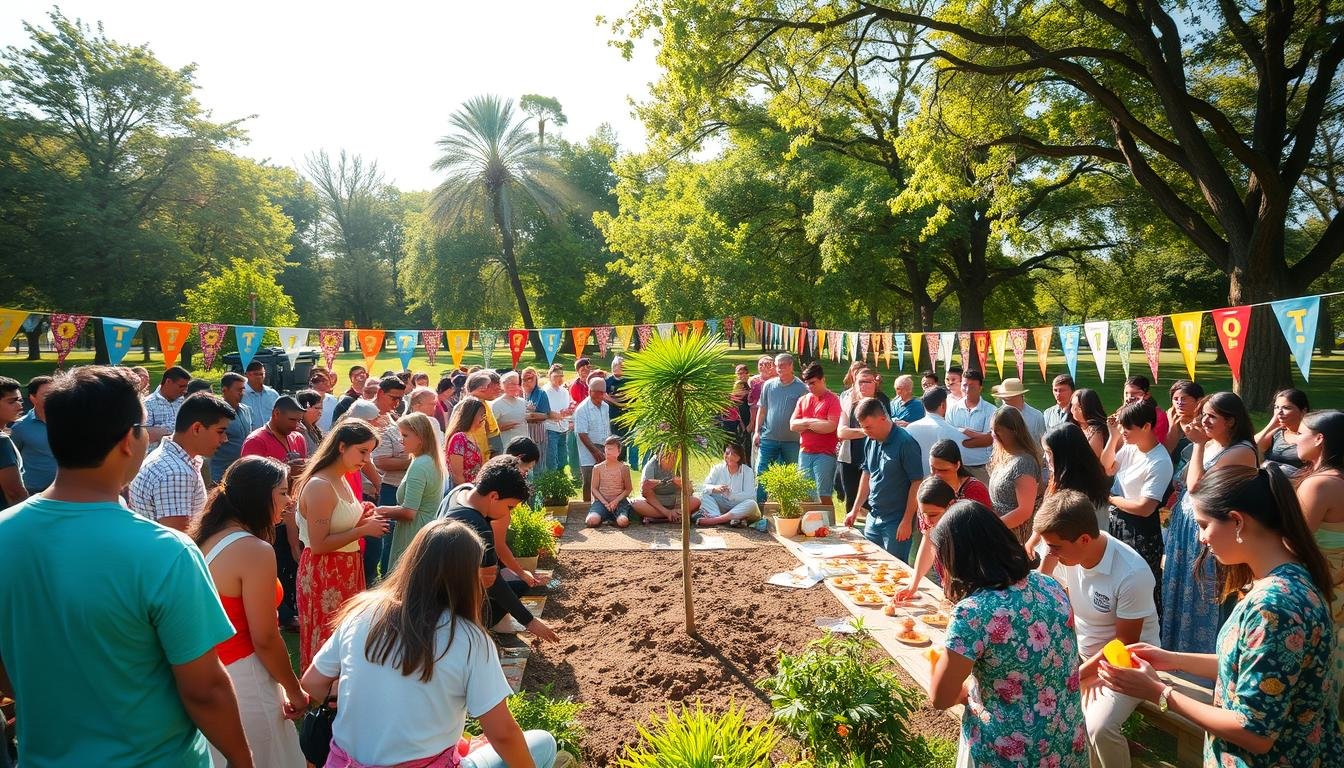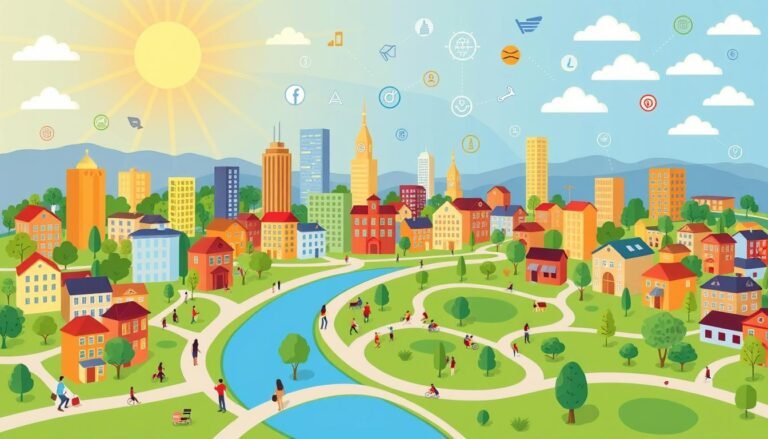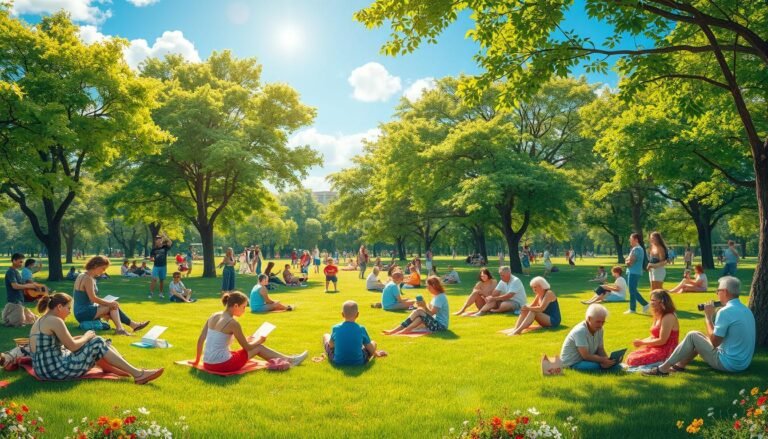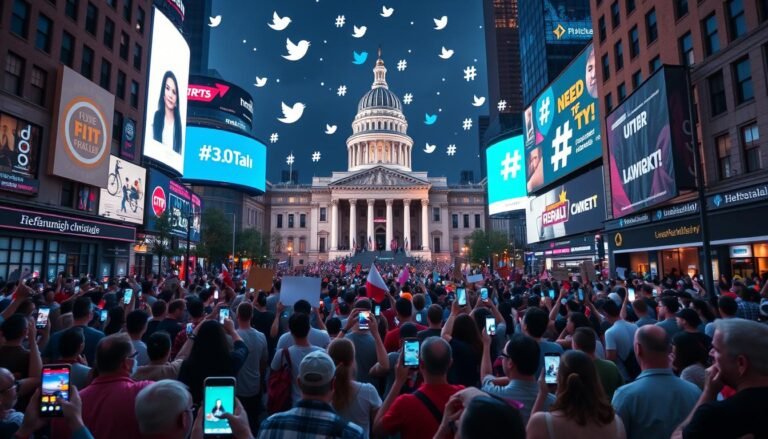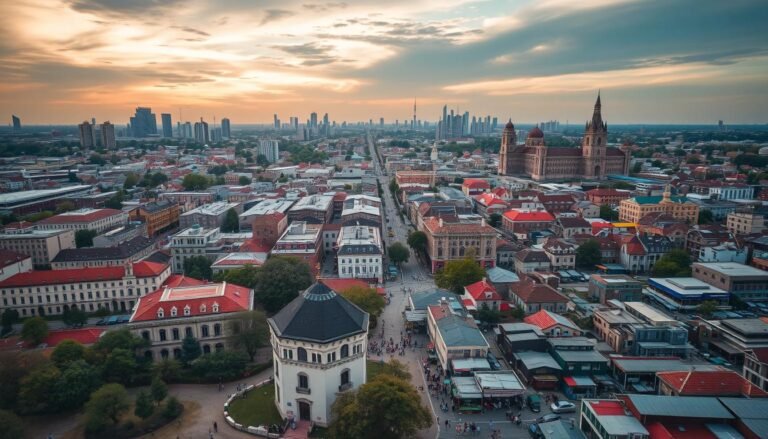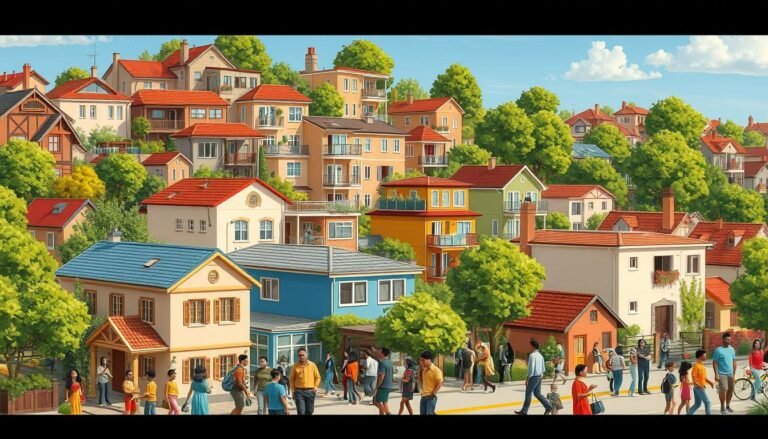Understanding Social Cohesion and Community Building
What keeps our neighborhoods, cities, and nations together? It’s social cohesion and community building. These ideas are key to our society, linking us all.
Social cohesion is the glue that keeps different groups together. It makes everyone feel they belong and share common goals. Community building is about making these bonds stronger and creating a shared identity.
In our fast-changing world, it’s more important than ever to understand social cohesion. Every part of our environment, from parks to local groups, shapes our communities.
Studies now show how vital these ideas are. For example, green spaces in cities help with health and stress, and they bring people together. In South Africa, the lack of green areas in poor and black areas shows we need to plan better together.
Looking into social cohesion, we see how important shared values and trust are. They help build societies that respect everyone’s rights and value human dignity.
Key Takeaways
- Social cohesion is key for strong, resilient communities
- Building communities makes social bonds and a shared identity
- Green spaces in cities help with social cohesion
- Planning together is important for fairness in social cohesion
- Knowing about social cohesion helps make fair, democratic societies
The Foundations of Social Cohesion
Social cohesion is key to a strong society. It’s about how well we connect, trust, and work together. Let’s explore what makes a community cohesive.
Defining Social Cohesion
Social cohesion is what keeps us united. It’s our readiness to cooperate and support one another. The Council of Europe views it as ensuring everyone’s well-being and fighting against marginalization. It aims to create a society where everyone feels included.
Key Elements of a Cohesive Society
Trust and cooperation are central to social cohesion. When we trust each other, we’re more inclined to work together. Civic participation is also vital. It means getting involved in our communities and having a say in decisions that impact us.
- Trust between neighbors
- Active community engagement
- Equal opportunities for all
- Strong social bonds
The Importance of Shared Values
Shared values bring unity in diversity. They provide a common foundation, even among differences. When we share values, we’re more likely to engage in our communities and take part in civic activities. This fosters stronger, more resilient societies.
“The willingness of members of society to cooperate with each other in order to survive and prosper.” – Dick Stanley on social cohesion
Building social cohesion is challenging. It requires effort from all of us. But the benefits are significant: stronger communities, better institutions, and a better life for everyone.
Understanding Social Cohesion and Community Building
Social cohesion is key to building inclusive societies. It means making strong connections among people and groups. It also means feeling like you belong and working together to solve problems.
Studies show that social cohesion affects many parts of our lives. It’s tracked through social capital and networks. These things help with health, cut down on violence, and make resources easier to get. For instance, having strong support from others helps with eating well and handling stress.
Building cohesive communities means:
- Promoting civic engagement
- Creating shared spaces for interaction
- Developing inclusive policies
- Encouraging cross-cultural understanding
Older adults who feel isolated face health risks and are more likely to die early. This was clear during the COVID-19 pandemic. To fight this, communities are starting social programs to improve health and bring people closer together.
“Social cohesion reflects people’s needs for personal development and a sense of belonging.”
By focusing on social cohesion and building communities, we can make societies stronger and more united. This process connects personal growth with fairness, efficiency, and sharing resources. As we work to bridge gaps, we’re building a future that’s more connected and supportive.
The Role of Community-Driven Development
Community-driven development (CDD) is key to building social capital and local growth. Over the last 25 years, the World Bank has put over $100 billion into CDD projects. This shows how serious they are about this method.
Promoting Social Capital in Fragile Environments
CDD works to increase social capital in tough places. Even though it may not show big changes right away, long-term efforts in places like India and Indonesia have gotten millions involved in local projects. This shows it can work well if it fits into what’s already there and is closely watched.
Implementing Micro-Projects for Local Development
Micro-projects are essential for CDD’s success. The World Bank has 327 ongoing CDD projects in 90 countries, worth $33 billion. These projects aim to better infrastructure, health care, and economic conditions. For example, community gardens can lower crime and boost property values.
Research and Analysis in Community Building
Research is crucial for understanding how CDD works. Studies reveal that mixing community oversight with clear facts can enhance health care. Yet, CDD isn’t always the answer, especially in unstable areas. Continuous research helps improve methods and keep communities involved.
“Community-led development can lead to more sustainable and inclusive development outcomes, social cohesion, and resilience.” – United Nations Development Programme
CDD focuses on these areas to build stronger communities and push local growth, even in hard places.
Human Rights Education as a Catalyst for Social Cohesion
Human rights education is key to bringing people together. It teaches individuals about their rights and those of others. This helps build a community with shared values and a sense of responsibility.
Programs that connect with local culture make it safe to talk about tough topics. They let everyone in society have a say, making sure no one is left out. By tackling human rights, communities can grow stronger and more united.
“Education is the most powerful weapon which you can use to change the world.” – Nelson Mandela
Worldwide, human rights education is making a big difference. The Convention on the Rights of the Child (1989) says every child should get an education. The Sustainable Development Goals (2015) also highlight the need for quality education for everyone.
In countries like Finland and Bhutan, human rights education is a big deal. Finland makes sure all kids are treated equally and included. Bhutan focuses on education that helps people grow morally, intellectually, and socially.
- Promotes understanding of individual and collective rights
- Fosters shared values and social responsibility
- Creates safe spaces for discussing sensitive topics
- Supports capacity-building within communities
By focusing on human rights education, we can create communities that respect and understand each other better.
Strategies for Promoting Shared Values
Building a strong community starts with shared values. These are the beliefs we hold dear that bind us together. They create a sense of belonging and help us work towards common goals.
Identifying Common Beliefs
To promote shared values, we first need to find what unites us. This can be done through community surveys or town hall meetings. Once identified, these values can be highlighted in local media and schools.
Encouraging Open Dialogue
Dialogue is key to understanding each other. Community events and forums provide spaces for people to share their thoughts and listen to others. This exchange of ideas builds bridges and fosters inclusivity.
Embracing Diversity
A cohesive community celebrates its diversity. Cultural festivals and educational programs can showcase different traditions, promoting mutual respect and understanding among various groups.
Building Civic Responsibility
Shared values come to life through civic engagement. Volunteering and community service projects give people a chance to work together and make a real difference. This hands-on approach strengthens social bonds and creates a sense of shared purpose.
By focusing on these strategies, communities can create a strong foundation of shared values. This leads to improved health, lower crime rates, and greater economic prosperity for all.
The Power of Cultural Heritage in Building Communities
Cultural heritage is key in making communities strong and connected. It gives everyone a common history that helps bridge gaps between groups. Local culture deeply affects how people talk and act, helping them understand their past and plan for the future.
A 2022 study found that 63% of adults visited a cultural site last year, mostly to be with family and friends. During the COVID-19 pandemic, 27% went to these sites to reconnect with others.
Projects to save heritage sites help make new friends and connections. Festivals focused on culture and heritage bring people together, creating strong social bonds. These events give community members a chance to meet and connect with others from different backgrounds.
“Culture contributes to building a sense of local identity and solidarity.”
Old cities and town centers are great for socializing because of their design. They help build a strong community feeling among locals. Heritage spots are like community centers, offering chances to meet new people and make stronger social connections.
| Benefits of Cultural Heritage | Impact on Community |
|---|---|
| Shapes local identity | Builds solidarity |
| Encourages social interaction | Strengthens relationships |
| Provides gathering spaces | Fosters sense of unity |
Understanding how cultural heritage helps build communities shows us its power. By using local culture in development plans, we can make communities stronger and more united.
Leadership’s Role in Strengthening Social Bonds
Leaders are key to building strong communities. A study of 210 Iban chiefs in Sarawak, Malaysia, shows how they impact community unity. It found that good leaders make people feel they belong and support each other.
Leading by Example
Ethical leadership sets the community’s tone. When leaders act with respect and include everyone, others do the same. In the Iban community, which is 30% of Sarawak’s people, their leadership is changing with the world. Yet, these leaders are still vital in keeping the community together.
Ethical and Moral Leadership
Trust in leaders varies around the world. In the US, just 2% always trust the government to act right. This lack of trust can block access to services and make solving problems harder. Ethical leaders focus on being open and dependable to gain trust. They always put the community’s well-being first.
Implementing Inclusive Policies
Inclusive policies help leaders build strong social ties. In Malaysia, the Ministry of Women, Family and Community Development leads in making policies for community growth. Leaders who include everyone in decisions promote fairness and equality. These are key to getting everyone involved.
“Trust is the key ingredient in partnership development, successful engagement, and greater health equity.”
By choosing ethical leadership and inclusive policies, leaders can create strong, united communities. Their actions weave the social fabric, making sure everyone feels important and connected.
Overcoming Challenges in Building Cohesive Communities
Building strong communities is tough. In the U.S., fast changes in who lives here have caused tension. Now, nearly one in seven Americans was born in another country as of 2017. This change brings both good and bad for community strength.
To bridge divides, we need to understand each other’s views. About 60% of Americans say they’re open to new ideas about community diversity. But, anti-immigrant feelings have grown louder. When people don’t know newcomers well, negative stereotypes can spread fast.
- Promote inclusive leadership with diverse voices in decision-making
- Improve education to build cultural understanding
- Create spaces for dialogue between different groups
- Address economic gaps through fair job opportunities
- Host cultural events to celebrate diversity
These steps can help build trust and unity. By working together, communities can turn challenges into growth chances. With effort, we can create stronger bonds across all backgrounds.
| Challenge | Solution |
|---|---|
| Language barriers | Free language classes |
| Cultural misunderstandings | Community dialogue events |
| Economic disparities | Job training programs |
| Lack of representation | Diverse leadership initiatives |
Conclusion: Towards a More Connected and Harmonious Society
Building strong communities is crucial for inclusive societies. Social media is playing a big role in this effort. For example, 90% of young adults in the U.S. use social media, which helps with diverse interactions and cultural exchanges.
Facebook’s “Love Has No Labels” campaign and Instagram’s body-positive influencers are helping to promote understanding and self-love. These efforts match the United Nations Development Programme’s (UNDP) work on social cohesion. They use over 70 indicators across different areas.
The UNDP’s work in Ukraine shows how community building can make a difference. Their #OneUkraine campaign and Tolerance Envoys program have increased national unity. By focusing on shared values and supporting diversity, we can build communities that value everyone. Let’s keep working on community development and human rights education for a more united world.
Source Links
- Fostering Equity: Creating Shared Understanding for Building Community Resilience | Center for Community Resilience | Milken Institute School of Public Health | The George Washington University
- The Dynamic Relationship between Social Cohesion and Urban Green Space in Diverse Communities: Opportunities and Challenges to Public Health
- What is social cohesion? | Scanlon institute
- Social Cohesion and Resilience
- Social Cohesion – Healthy People 2030
- Social Cohesion
- Where and When is Community-Driven Development (CDD) Effective?
- How Community Building is Building a Better World?
- Education and Human Rights: Pillars of a Just Society – Education Uplifted
- The Interconnection Between Education and Human Rights – Education Uplifted
- Building social cohesion through shared values
- Social Cohesion: Fostering Unity and Harmony in Communities
- Importance of Incorporating Local Culture into Community Development
- The Role of Heritage in Bringing People Together | Heritage Counts | Historic England
- The influence of leadership quality towards community cohesion in Iban community in Malaysia
- Building trust: Leadership reflections on community empowerment and engagement in a large urban initiative
- Leadership and oversight in building social cohesion
- Essential Elements for Building a Cohesive Society
- Social Cohesion and Community Resilience During COVID-19 and Pandemics: A Rapid Scoping Review to Inform the United Nations Research Roadmap for COVID-19 Recovery
- How are Financial Services Employers Shaping the Future of Through Employer Diversity Certification?
- Connecting communities through social cohesion

